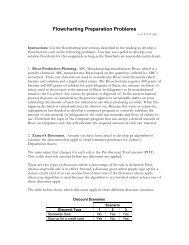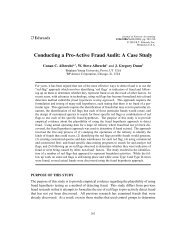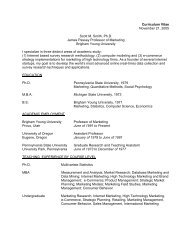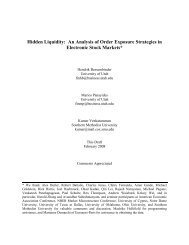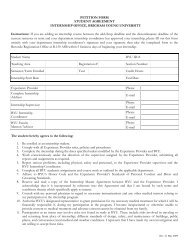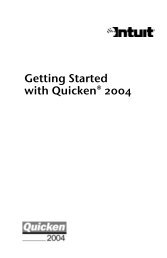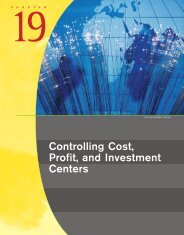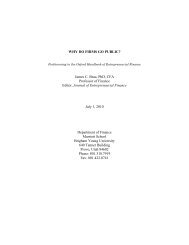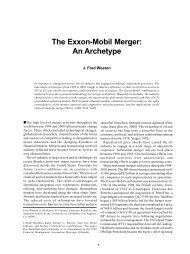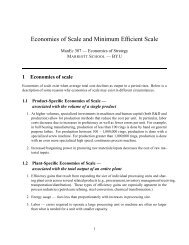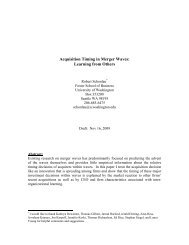The Limit Order Book and the Break-Even ... - Marriott School
The Limit Order Book and the Break-Even ... - Marriott School
The Limit Order Book and the Break-Even ... - Marriott School
Create successful ePaper yourself
Turn your PDF publications into a flip-book with our unique Google optimized e-Paper software.
THE LIMIT ORDER BOOK AND THE BREAK-EVEN CONDITIONS REVISITED 7<br />
<strong>the</strong> order size, v(δ) = E[ṽ|˜δ = δ], <strong>and</strong> v + (δ) = E[ṽ|˜δ > δ]. <strong>The</strong> expected profit of a<br />
marginal offer is<br />
u(x, y) = E(x − ṽ)I { δ>y} e = x(1 − F (y)) −<br />
= (x − v + (y))(1 − F (y))<br />
∫ ∞<br />
y<br />
v(u)dF (u)<br />
<strong>The</strong> relevant region is D = {(x, y) : F (y) < 1}, <strong>and</strong> <strong>the</strong> probability of execution is<br />
ɛ(x, y) = (1 − F (y)).<br />
2. <strong>The</strong> <strong>Break</strong> <strong>Even</strong> Conditions<br />
Following Rock (1990) <strong>and</strong> Glosten (1994), it is common to posit that when <strong>the</strong>re<br />
are infinitely many liquidity suppliers <strong>and</strong> it is costless to post offers <strong>the</strong>n <strong>the</strong> supply<br />
function satisfies <strong>the</strong> break even conditions:<br />
[<br />
]<br />
x ≤ E ṽ|˜δ(y(·)) > y(x)<br />
with equality whenever dy(x) > 0. <strong>The</strong> right h<strong>and</strong> side is commonly called <strong>the</strong> “upper<br />
tail expectation.” We may have a strict inequality because <strong>the</strong>re are prices at which<br />
even competitive liquidity suppliers do not offer shares (e.g., prices that are below<br />
<strong>the</strong> ask price).<br />
An economic environment is said to be regular if: (i) <strong>The</strong>re is a unique supply function,<br />
which we denote by y ∞ (·), that satisfies <strong>the</strong> break even condition, <strong>and</strong> (ii) In <strong>the</strong><br />
relevant region D, <strong>the</strong> sign of u(·, ·) is negative above <strong>the</strong> graph of y ∞ (x) <strong>and</strong> positive<br />
below <strong>the</strong> graph. 8 We denote by ask ∞ <strong>the</strong> ask price that corresponds to <strong>the</strong> supply<br />
function y ∞ (·).<br />
Though our analysis is general, we are only interested in regular economic environments<br />
where <strong>the</strong> argument for <strong>the</strong> break even conditions sounds appealing. In a<br />
regular economic environment, <strong>the</strong> following procedure can be used to construct <strong>the</strong><br />
supply function y ∞ (·): ask ∞ is <strong>the</strong> smallest positive root of x → u(x, 0). For all<br />
x < ask ∞ , we set y ∞ (x) = 0. For all x > ask ∞ , we set y ∞ (x) to be <strong>the</strong> value where<br />
<strong>the</strong> function y → u(x, y) changes signs.<br />
8 <strong>The</strong> graph of y ∞ (·) is a subset of <strong>the</strong> positive quadrant: it is <strong>the</strong> collection of all <strong>the</strong> pairs (x, y ∞ (x)).



